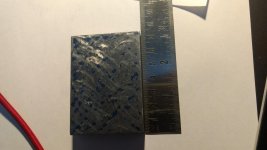Luke Rickert
Hot Rolled
- Joined
- Oct 24, 2007
- Location
- OSLO
Hi this is part of drill press vise project but also closely resembles a 2 by 3 inch rectangle of cast iron. I am finding that I end up with sparsely spaced high points. Any suggestions? Do I need a different radius on the scraper, better separation between each scrape or something else to try. The current radius is around 50mm maybe a bit tighter towards the edges.
thanks
luke

thanks
luke




